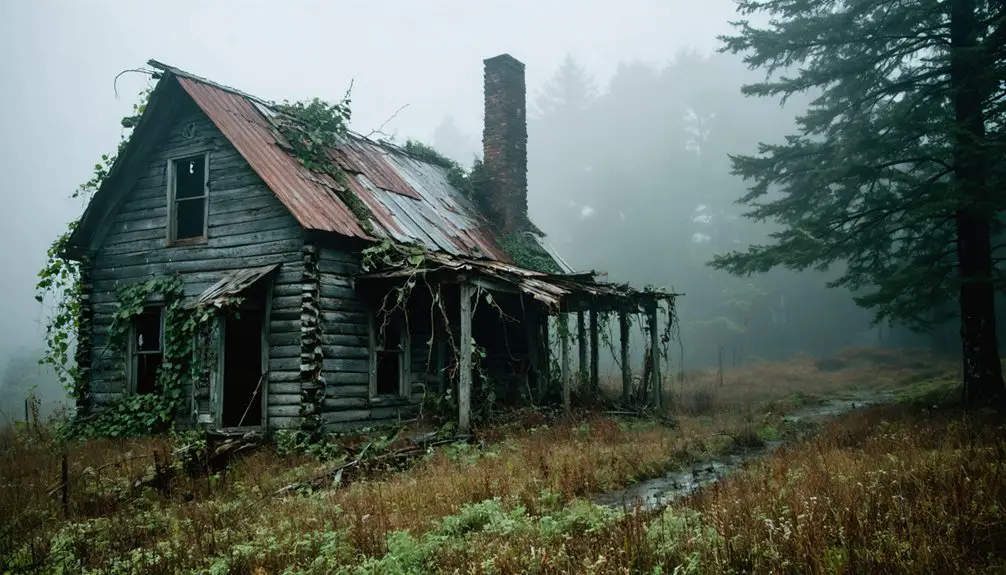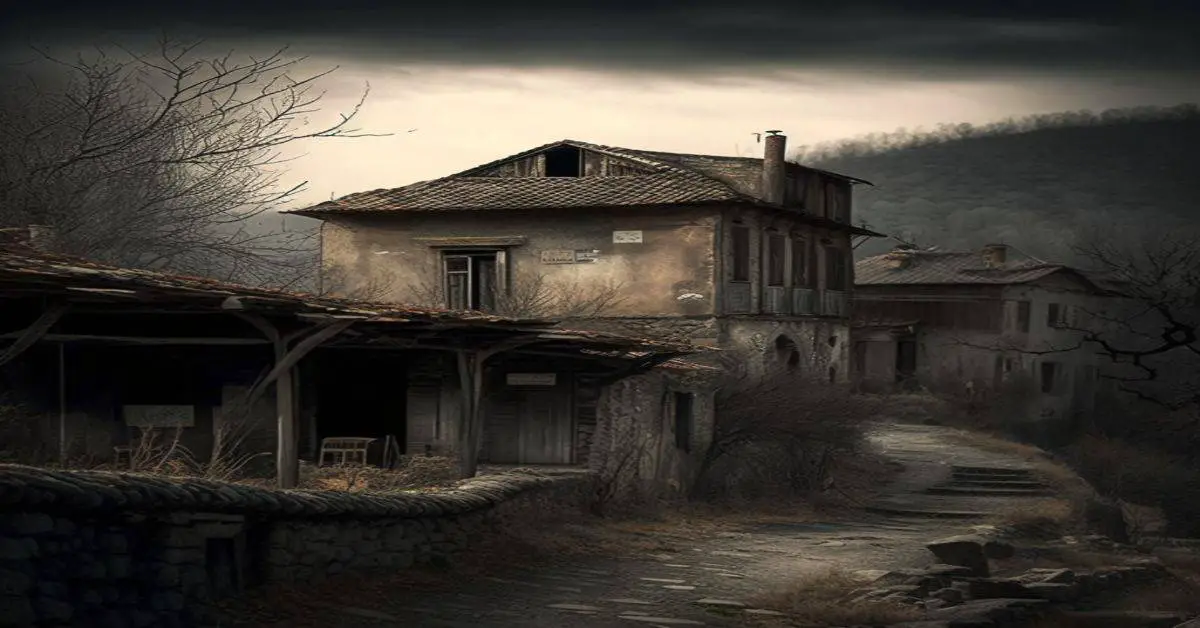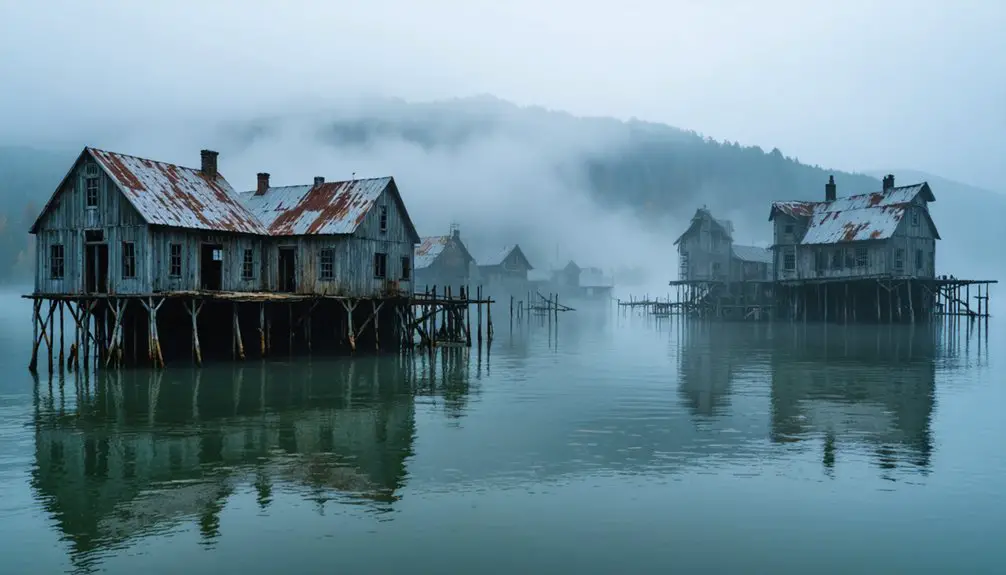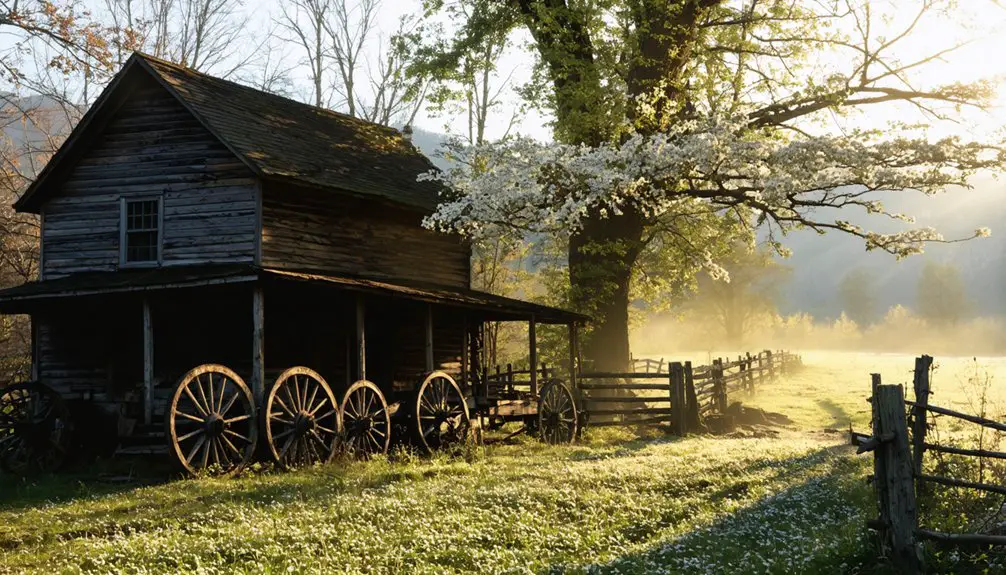You’ll find No Business, Tennessee nestled along No Business Creek in the Cumberland Plateau, where Revolutionary War veterans first settled in 1796. Pioneer families like the Slavens, Crabtrees, and Blevins built a thriving community of scattered homesteads connected by footpaths and horse trails. The settlement flourished through farming and logging until World War II, when younger generations left for urban opportunities. Today, nature has reclaimed this ghost town’s remnants, though its stories still echo through the mountain wilderness.
Key Takeaways
- No Business, Tennessee was established in the late 1700s along No Business Creek by Revolutionary War veterans and early pioneers.
- The community thrived through farming, logging, and family networks until economic challenges and World War II led to population decline.
- Pioneer families like Crabtrees, Blevins, and Slavens built homesteads connected by footpaths, forming a self-sustaining community near the creek.
- Today, the ghost town’s remnants are largely concealed by overgrowth, requiring careful exploration and proper permissions to visit.
- The settlement’s decline accelerated when post-WWII veterans chose urban opportunities over rural life, eventually leading to abandonment.
The Birth of a Mountain Settlement
Three distinct waves of settlers ventured into the rugged Big South Fork region between 1778 and 1800, establishing what would become No Business, Tennessee.
You’ll find their pioneer settlement took root along No Business Creek, where Revolutionary War veterans like Richard Slaven carved out homesteads from the wilderness in 1796.
These early settlers didn’t arrive by chance – they followed ancient Native American trails that wound through the Cumberland Plateau’s challenging terrain.
Native pathways, forged through countless generations, guided these pioneers across the rugged Cumberland landscape into their new frontier home.
They’re part of a broader westward migration that shaped the mountain culture of the region.
While facing isolation and harsh conditions, they built a self-reliant community drawing sustenance from the land’s natural bounty.
They transformed footpaths into wagon roads, cleared forests for farming, and established the foundations of a distinctive Appalachian community.
The settlers built humble log cabins and barns using native timber to establish their first homes.
The abundant wildlife and fish in the New River area provided sustenance for these determined settlers.
Pioneer Families and Early Life
Life in No Business Creek revolved around a tight-knit group of pioneering families who’d forged deep ties to the land and each other.
You’d find the Crabtrees, Blevins, Boyatts, Burkes, Slavens, and Millers clustered along the creek bottoms, where they built homesteads on the best farmland near reliable water sources.
Much like the summer cabin community of Elkmont established in 1910, settler experiences centered on self-sufficiency, with families working the land while maintaining strong community traditions.
The region’s early growth paralleled other mountain communities, with Little River Lumber establishing extensive timber operations in the area.
You’d see neighbors gathering at the one-room schoolhouse, local churches, and general stores that dotted the creek valleys.
These spaces weren’t just practical – they were the heart of mountain society, where stories were shared and bonds strengthened.
Richard Slaven, a Revolutionary War veteran, blazed the trail in 1796, establishing a legacy that would support nearly 300 residents at the community’s peak.
Daily Living Along No Business Creek
If you’d ventured along No Business Creek in its heyday, you’d have found families living in scattered homesteads connected by worn footpaths and horse trails that followed the creek’s winding course.
Your family’s survival would’ve depended on maintaining a self-sufficient farm, where you’d grow your own food, raise livestock, and preserve enough to last through winter.
You’d have relied on the creek not just for water, but as a natural pathway to reach neighboring farms, sharing tools and labor during harvest times or barn-raisings. Much like the residents of Victorian Village in Memphis, these homes stood as testament to their era, though they met a different fate than their grand urban counterparts.
Like many Tennessee ghost towns, the community’s decline was hastened by the advent of modern transportation, which shifted trade routes and economic patterns.
Creek Access Transportation Routes
While traversing No Business Creek today requires careful planning, the area’s extensive network of jeep roads, horse trails, and hiking paths provides multiple access points from key locations like Divide Road, Hatfield Ridge, and the Chestnut Ridge Loop.
You’ll find creek crossings throughout the valley, though some become impassable during high water. Access trails connect to the historic O&W railroad bed, which serves as a scenic gravel route paralleling Pine Creek and Big South Fork. Some sections of trail require short hike-a-bike segments to navigate challenging terrain. The rough terrain features steep drop-offs that may challenge less experienced riders.
- Station Camp Road and Brewster Bridge offer reliable river access points
- The No Business Loop bikepacking route covers 103 miles of mostly unpaved terrain
- Unaka Spring Road leads to No Business Knob trailhead through forest service gates
- Multiple jeep roads connect to Bandy Creek and surrounding watersheds
- Toomey Road and Black Creek Road provide vehicle access near Mountain View
Family Farm Self-Sufficiency
Along No Business Creek, families mastered the art of complete self-sufficiency through a combination of subsistence farming, resourceful water management, and skillful preservation techniques.
You’d find homesteads practicing efficient crop cultivation, rotating corn, beans, and potatoes in their fields while tending vegetable gardens near their homes. They’d raise chickens, pigs, and cows for sustenance, making use of the creek’s water for both household needs and livestock. Similar to the stone fireplaces and fountains that dotted the landscape, the creek served as a central gathering place for the community.
You’ll notice how they didn’t waste anything – they’d smoke their meats, can their vegetables, and store root crops in cellars. Much like the social clubs and residents of Elkmont, they built a strong sense of community through shared activities and gatherings.
They’d craft their own tools, make their own soap, and repair their equipment. When extra hands were needed, they’d rely on neighbors and kin, trading skills and labor to keep their independent way of life thriving.
Community Bonds and Social Structure
You’ll discover that family networks formed the backbone of No Business’s tight-knit community, with the Slavens, Crabtrees, and Blevinses sharing both bloodlines and daily life along the creek bottoms.
The local church served as more than a spiritual center—it’s where families gathered for worship, socializing, and maintaining the bonds that kept this isolated community strong.
Neighbors regularly pitched in with farm work, shared tools and equipment, and relied on each other during difficult times, creating an intricate web of mutual support that defined life in this Appalachian settlement.
Family Ties and Support
Deep in the heart of No Business, Tennessee, extended family networks formed the bedrock of community life, with surnames like Crabtree, Blevins, Boyatt, Burke, Slaven, and Miller dominating the social landscape.
These tight-knit family groups settled along the creek’s natural boundaries, creating a web of mutual support that sustained the community through generations. You’ll find evidence of their resourcefulness in the way they shared responsibilities and resources, from working the fertile bottomlands to maintaining essential infrastructure.
- Extended families operated shared grist mills and local stores
- Children’s education brought families together in one-room schoolhouses
- Collective labor during harvest seasons strengthened family bonds
- Swinging bridge maintenance required coordinated family effort
- Shared oral traditions preserved family histories across generations
Church and Social Gatherings
While isolated homesteads dotted the rugged landscape of No Business, churches served as the spiritual and social anchors that bound the community together.
You’d find these houses of worship buzzing with activity beyond Sunday services, as they hosted everything from picnics to holiday celebrations along the creek bottoms.
Church activities weren’t just about religion – they were essential threads in the fabric of daily life. You’d see families gathering for seasonal festivals, sharing news, and strengthening bonds through communal meals.
The social cohesion fostered by these gatherings helped sustain the community through challenging times. When disputes arose, clergy and lay leaders stepped in as mediators.
In this remote settlement, the church building stood as both a physical landmark and a symbol of unity, where scattered neighbors became a tight-knit community.
Living in No Business demanded a tightly woven network of cooperation, where families relied on each other’s labor and resources to survive the rugged Tennessee terrain.
You’d find homesteads strategically clustered along stream bottoms, with families like the Crabtrees, Blevins, and Slavens forming the backbone of community cooperation.
Through informal work exchanges and resource management, these settlers maintained their independence while supporting each other’s survival.
- Neighbors pooled labor for intensive tasks like barn-raising and harvest
- General stores served as trading hubs where you could barter goods and services
- Extended family networks provided essential support during hardships
- Community boundaries followed natural watersheds, uniting families within drainage systems
- Shared access to timber, game, and water was managed through informal agreements
The Rise of Local Industries
Although No Business began as a farming settlement, its economic foundation gradually expanded through the rise of resource-based industries in the late 1800s.
You’ll find that the local economy shifted as commercial logging operations transformed the Big South Fork region, offering employment opportunities beyond traditional farming. This industrial change brought significant changes to the community’s way of life.
While nearby towns like Tharpe developed iron ore industries and later shifted to lumber production, No Business remained relatively modest in scale.
The timber industry’s presence shaped daily life, but without sufficient economic diversification, its eventual decline hit hard. As logging diminished by mid-20th century and young men left after WWII, the community couldn’t sustain itself through farming alone, contributing to its eventual abandonment.
Challenges of Mountain Isolation
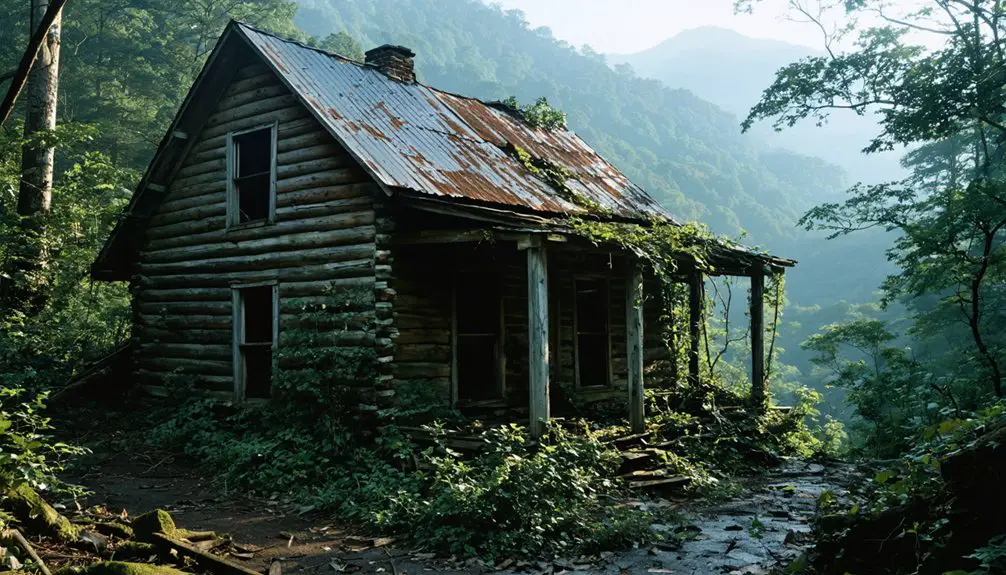
Situated deep within the rugged Cumberland Plateau, No Business faced extraordinary challenges due to its mountain isolation.
You’d find homesteads scattered among steep ridges and stream bottoms, where daily life meant maneuvering through treacherous terrain and weathering prolonged periods of seclusion. The isolation effects rippled through every aspect of community life, from limited economic opportunities to restricted social interactions.
- Rocky, rutted roads forced residents to hike rather than drive
- Winter weather could cut off access entirely for weeks
- Local stores and schools were few and far between
- Young folks left seeking opportunities beyond the mountains
- Transportation difficulties made getting supplies a constant struggle
These mountain challenges eventually took their toll, as the once-thriving community of 300 dwindled, especially after World War II drew many residents away permanently.
World War II’s Impact and Population Decline
When World War II erupted, it dealt a devastating blow to No Business’s already fragile community fabric.
You’ll find that the war impact rippled through every aspect of local life as young men either enlisted or were drafted, stripping the community of its essential workforce. This population migration proved permanent, as returning veterans, having experienced life beyond the mountain hollow, chose urban opportunities over their former agricultural lifestyle.
The community’s decline accelerated as wartime industrial growth drew remaining residents to Tennessee’s cities.
You’d notice how the mechanization of farming and shifts in agricultural practices made No Business’s traditional subsistence patterns obsolete. Without its youth and unable to adapt to modern economic demands, the isolated mountain community couldn’t sustain itself, ultimately sealing its fate as a ghost town.
The Last Days of No Business
Despite the community’s resilient spirit, No Business entered its final chapter in the 1950s as economic hardships and isolation took their ultimate toll.
You’d have witnessed the gradual shuttering of local stores, schools, and churches that once formed the heartbeat of this mountain community. The last resident, Dewey Slaven, finally departed in 1960, marking the end of an era that began with his ancestor Richard Slaven’s settlement in 1796.
The mountain valley fell silent as its last lifeline departed, closing a generational chapter that spanned over 160 years.
- General stores where neighbors once gathered now stood empty
- One-room schoolhouses fell silent as families relocated
- Church bells ceased ringing across the valley
- Community memories lived on through scattered family photographs
- Mountain paths that once connected homesteads slowly faded into wilderness
The rugged landscape that initially sheltered the community’s independent spirit ultimately contributed to its final days as a ghost town.
Natural Beauty and Historical Legacy
The rugged terrain of the Cumberland Plateau cradles No Business’s enduring natural legacy, even as its human inhabitants have long departed.
You’ll find steep ridges and valleys blanketed in oak-hickory forests, where white-tailed deer and wild turkeys roam freely through the understory’s native wildflowers.
Through natural preservation efforts, you can still witness the ecological tapestry that sustained generations of settlers.
The landscape tells a story of historical ecology – from the springs that once powered local mills to the timber that built community structures.
Today’s conservation initiatives protect these living connections to the past, while archaeological studies reveal how residents adapted to the plateau’s distinctive karst topography.
You’ll discover that No Business’s heritage lives on in its limestone caves, meandering streams, and the enduring rhythms of its seasonal cycles.
Exploring the Ghost Town Today
Modern-day explorers of No Business will find themselves traversing an untamed wilderness where nature has steadily reclaimed the remnants of human settlement.
Time has erased No Business from the map, leaving only wild spaces where a forgotten mountain community once thrived.
You’ll need to navigate carefully through dense vegetation to spot traces of abandoned structures and hidden artifacts that hint at the town’s past. Without marked trails or amenities, you’re free to forge your own path through this forgotten corner of eastern Tennessee, though you’ll want to secure necessary permissions and bring essential supplies.
- Foundation stones peek through thick underbrush, marking where buildings once stood
- Metal fragments and pottery shards occasionally surface after heavy rains
- Off-road vehicles can access some areas, but foot travel provides the best exploration
- Original town layout remains mysterious due to extensive natural overgrowth
- Photographers discover unique shots where wilderness meets historical remnants
Frequently Asked Questions
How Did No Business Creek and the Settlement Get Their Unusual Names?
You’ll find the name’s origin comes from local lore about the creek’s remote location – folks said there was “no business” for outsiders in this isolated area during early settlement days.
What Happened to the Buildings and Structures After the Town’s Abandonment?
You’ll find a classic pattern of urban decay – like the old general store’s collapsing roof – where most structures succumbed to nature, though some stone foundations remain for historical preservation along hiking paths.
Are There Any Surviving Photographs of No Business During Its Peak Years?
You won’t find peak-era photos since photography wasn’t invented during No Business’s heyday. Despite its historical significance, photographic evidence only exists from the 1970s, showing abandoned remnants of the settlement.
Did Any Paranormal Activity or Ghost Stories Emerge From the Abandoned Settlement?
You’d think a ghost town would have ghost stories, but there’s no documented ghost sightings or local legends from No Business. Unlike other Tennessee abandoned settlements, it’s kept its paranormal profile surprisingly quiet.
What Crops and Livestock Were Primarily Raised by No Business Farmers?
You’ll find their crop diversity centered on corn, wheat, and garden vegetables, while their livestock management focused on cattle, hogs, and poultry, with horses supporting essential farming operations.
References
- https://www.tnvacation.com/articles/ghost-towns-tennessee
- https://www.tnmagazine.org/19-ghost-towns-in-tennessee-that-are-not-underwater/
- https://www.nps.gov/biso/learn/historyculture/nobusiness.htm
- https://kids.kiddle.co/List_of_ghost_towns_in_Tennessee
- http://www.discoverscott.com/main/blog/a-hike-with-history/
- https://scottcounty.com/welcome/our-history/
- https://www.indherald.com/p/the-stories-of-the-big-south-forks
- https://www.nps.gov/biso/learn/historyculture/tragictale.htm
- https://www.mountainproject.com/area/114343961/no-business-creek
- https://www.youtube.com/watch?v=ElOFzZBcKTA
